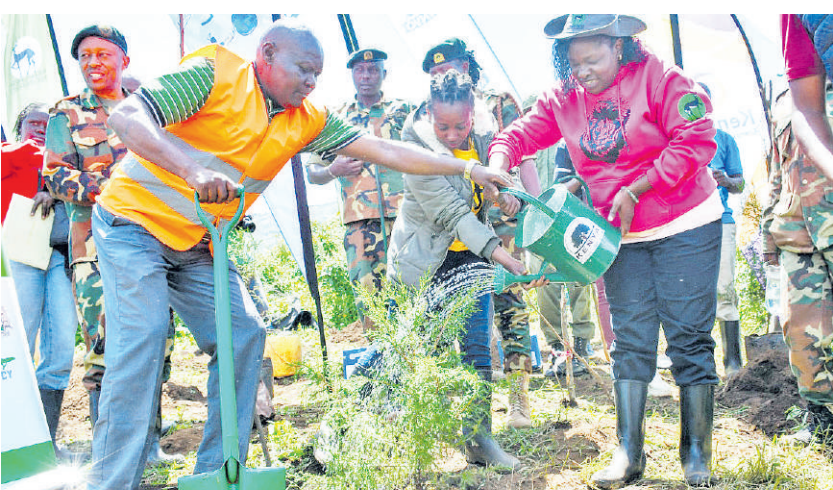

A few years ago, Kinale forest in Kiambu County was heavily degraded.
The area around the forest hit the headlines on April 29, 2024, when floods killed over 60 people.
A tunnel in the hilly area of old Kijabe road had accumulated water due to blockage along the railway line, and the increased water soaked the walls, sweeping away homes.
The residents now understand the importance of restoring the degraded area by planting red cedar, a species that was initially common in the area before it was cleared.
Today, the landscape has undergone a major transformation as a result of the concerted efforts of the Kinale Community Forest Association and partners. Loyce Mwaura is among the farmers who have been allocated land to grow early-maturing crops, as she tends to red cedar planted by partners in ongoing restoration efforts meant to bring back the lost glory of Kijabe.
“I plant crops such as potatoes and pyrethrum. I harvest the pyrethrum two weeks before drying it and delivering it to the market. It has helped provide for my family,” Mwaura, a mother of four, said.
She was allocated the land under the Plantation Establishment and Livelihood Improvement Scheme (Pelis).
Pelis is a system under which KFS allows forest-adjacent communities, through CFAs, to grow crops during the early stages of forest plantation establishment. Cultivation is often allowed to continue for three to four years, until the tree canopy closes, to improve the economic gains of participating farmers while ensuring the success of the trees.
Officials from the CFA and the Kenya Forest Service ensure that the trees are cared for, even as beneficiaries tend to their crops.
Trees that die are immediately replaced. The Pelis system has been used to establish forest plantations in Kenya since 2007.
Danson Njoroge, 75, plants beans, potatoes, and pyrethrum in his plot while taking care of the trees.
“The system has helped improve our livelihoods as we plant crops while tending to the trees,” he said.
Naomi Njeri, 40, has also benefited from the system by planting pyrethrum in her two plots.
On May 16, about 20,000 red cedar trees were planted at Kinale forest’s Old Kijabe block as part of the ongoing efforts to restore the area.
East Africa Wildlife Society advocacy and programmes manager Jabes Okumu said red cedar was selected as it initially covered the area. But since the tree is in high demand, it was cleared for timber.
Red cedar seed banks are common. This means if the area is undisturbed for several years, it can regenerate.
Okumu said the area was becoming hot, but the ongoing rehabilitation has cooled temperatures.
“The initiative is community-driven and owned. Young people, women, and old men are employed to undertake restoration efforts, earning a living,” Okumu said.
Members of CFAs have improved their livelihoods as they sell tree seedlings from their nurseries for restoration efforts and are allowed to grow crops.
The money collected from an initiative known as Forest Challenge is used to restore the degraded areas.
“Forest Challenge is used to catalyse interest among corporates and provide resources for restoration efforts,” Okumu said.
Participants enjoy nature by taking part in competitive fun activities in Kereita forest, which forms part of the larger Aberdare forest.
Forest Challenge seeks to restore lost forest cover in key water catchment areas in Kenya that are essential to supporting livelihoods and the survival of wildlife ecosystems.
The challenge aims to raise funds to continue the restoration of key water towers by rehabilitating at least 1,500 acres, equivalent to planting at least 600,000 indigenous tree seedlings over 10 years. It was launched in 2014 by the East Africa Wildlife Society, Kijabe Environment Volunteers, and the Kenya Forest Service. Aberdare forest reserve, part of the Aberdare ecosystem, plays a critical role in water catchment for the country and is one of the five main water towers in Kenya.
The eastern part of the mountain is the catchment for the Tana and Athi rivers, and the northeastern slopes form the catchment area for the Ewaso Nyiro River, which traverses the dry areas of Laikipia and Isiolo and drains into the Lorian swamp.
Malewa River, on the western side of the mountain range, drains into Lake Naivasha, while the Aberdare Range supplies water to Nairobi through Sasumua and Ndakaini dams.
Together with Mt Kenya, the bulk of the country’s hydroelectric schemes along the Tana River rely on water from these catchments.
Many small weirs have been installed in the forest to supply water to adjacent communities.
Acting deputy Chief Conservator of Forests Thomas Kiptoo lauded the restoration efforts, saying they will boost the government’s goal of planting 15 billion trees in the next 10 years.
“I would also want to thank all the other participants for their contributions, as achieving 30 per cent forest cover is a collective responsibility for every Kenyan, as outlined in the constitution,” Kiptoo said.
Besides selling seedlings and providing labour, residents also earn from nature-based enterprises.
EAWLS executive director Nancy Ogonje thanked the partners for their support in the 2024 Forest Challenge, noting that the funds raised from the event have enabled community participation in the forest restoration programme.
This year’s Forest Challenge will take place on November 29.
KENVO executive director Nelson Muiru said the rehabilitation has not only improved livelihoods but also created and supported forest conservation awareness.
Kinale Community Forest Association chairman Daniel Njinu said they have planted 429,000 indigenous seedlings in Kinale.

![[PHOTOS] KPC signs a service legal agreement with KEBS](/_next/image?url=https%3A%2F%2Fcdn.radioafrica.digital%2Fimage%2F2025%2F07%2Fa63c369d-7d4d-4a8c-bef9-34dba4c6d536.jpg&w=3840&q=100)









